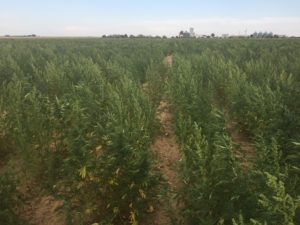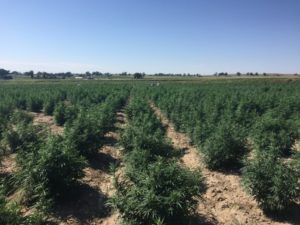Dr. Calvin Trostle, Extension Agronomy, TAMU Soil & Crop Sciences, Lubbock, TX
(806) 723-8432, ctrostle@ag.tamu.edu
September 11, 2019
The discussion of industrial hemp, particularly for cannabidiol (CBD), continues unabated in Texas. Colleagues report they hear as many as four hemp processing facilities being proposed in a local area. I can only imagine there are double and triple the number of CBD processing facilities being proposed versus those already in operation in other states. Texas A&M AgriLife is increasing our knowledge of industrial hemp. Several information programs across the state are being planned by Texas A&M or AgriLife personnel are participating as program speakers.
Prospective producers notice there are several organizations and websites seeking to be a voice in the future of Texas hemp. AgriLife is aware of just one Texas organization that is fully farmer-driven and coordinated by farmers. They will be going public later this month. AgriLife encourages prospective attendees at hemp information meetings to keep an open mind and ask pointed questions. Again, beware the hype. For example, a planned CBD processing facility: only when you see dirt move and walls going up will the uncertainty about these many plans be eased.
Recent Colorado & New Mexico Farm Visits
Texas A&M AgriLife staff visited CBD hemp farms in Rocky Ford, Colorado on August 20th (Fig. 1). I made an additional visit to a completely different type of hemp farm—3,200 acres in hemp production—later in the day. You hear repeatedly for CBD production there must be no male pollen near the field. The second Colorado site challenges that concept. Planting from seed, about 50% of the plants in the irrigated field are male. Planned harvest is for hemp CBD and seed (Fig. 2). I dearly hope we will learn what %CBD was achieved—that result will have a huge impact on how CBD may be produced moving forward. These fields were managed with conventional sprinkler irrigation and without the expense subsurface drip irrigation and/or plastic mulch sheeting that is often advocated. The farmer also had dryland hemp (Fig. 3).
An AgriLife Today news release summarizes the trip, see https://today.agrilife.org/2019/08/27/agrilife-extension-explores-hemp-issues-answers-in-oklahoma-colorado-tour/
Fig. 1. Wide spacing of transplants with furrow irrigation for high %CBD industrial hemp production, Colorado.
Fig. 2. Colorado industrial hemp production from seed, which includes ~50% of male plants (lighter colored due to senescence), using sprinkler irrigation. Harvest yield of lower %CBD will be of interest to compare to more expensive production using transplants or feminized seed. Irrigation levels approach 15”.
Fig. 3. Colorado dryland production of industrial hemp from seed (hence male plants in the field). Harvest will separate grain (potential planting seed) from plant biomass for CBD processing. Analysis of CBD yield and grain will determine economics of production. Will %CBD be high enough to merit processing? (The grower is hoping for 5 to 6% CBD.) Summer 2019 rainfall is slightly below average but deep soil moisture at planting was very good.
I made a subsequent visit to a farm that planted over 2,000 acres of hemp in Union Co., NM. I will follow this up with a visit to a hemp breeding program in Corona, NM on September 13. The information I am learning will be helpful in aiding Texas producers making decisions about whether to try growing hemp and if so, how it will be done. The Union Co. example highlighted a sound principle that may help Texas growers manage risk. Not only did the farmer have a detailed contract—reviewed by his own attorney—with the buyer, but especially, the buyer provided the genetics (in this case feminized seed). Cost of planting material (seed, feminized seed, transplants, clones) is the source of some of the most excessive expenses a prospective producer faces.
One Colorado grower said a producer absolutely should not pay more than $4 per single transplant, but this is still excessive. Do they really cost that much to produce? Or does feminized seed truly cost $1 per seed? These are prices AgriLife expects will fall considerably soon, perhaps even as early as next year. Therefore, I like the concept of the above NM farmer’s buyer—who would be in a much better position to know what the actual cost should be (and not overpay)—providing the genetics. Going forward, as a prospective producer ask potential contractor/buyers how they will help you manage huge economic risks. Sharing arrangement on genetics could be one key consideration.
Status of Hemp Regulations for Texas
USDA has still not released their proposed regulations for public comment. Once those come out then states (who probably already have a good feel for what they will be) will begin finalizing their own draft rules. I am still unsure when the process will be completed. Or when Texas hemp farmers and businesses may begin applications for licensing, etc. We hope they are here early in 2020, especially as we are learning from growers in CO and NM that they believe they should be planting earlier (e.g., possibly by March 1 for the Lubbock area?—AgriLife sees time of planting a likely area for initial research).
Another area of regulation or application of standards that producers should be highly interested in is the hemp seed industry. As noted above most hemp seed and feminized seed sources are not pure. Standards need to be applied in the seed industry to protect growers from off types or planting seed that claims a genetic variety but is not. For the current cost of the seed, farmers need this assurance. A Midwest farmer notes deception and fraud in the hemp seed industry as a major concern for hemp growers. You can read his comments in a Farm Journal report at https://www.agweb.com/article/hemp-pitfalls-and-promise-alarm-sounded-midwest-grower This is recommended reading for many other reasons as well (many hemp farming risks that are excessive).
Perspective on the Retail Cost of Hemp CBD Products—What does the farmer receive?
Last week I examined three examples of CBD products (tablets, liquid) that sell commercially for $30 per unit. Each contained 250 milligrams (0.00882 ounce) of CBD. (A similar commercial product containing 250 mg CBD pictured at right; sales price of this brand is unknown.) My question: how much of that sales prices goes to the producer? I make some reasonable assumptions based on 2018 prices paid to a farmer, processing efficiency, etc. ($4 per each percent of CBD in 1 lb. of dried raw material; some Colorado producers report their agreements are just $2 per one percent of CBD). The result?—only $0.22, or as little as 0.7% of the $30 commercial sales price! (By comparison, the value of wheat to produce bread is 6 to 7% of the sales price.) So even though under current economics there is potentially very high revenue to a CBD
producer, you can see there is a tremendous mark-up through processing and sales. And for products whose effect is largely uncertain. A producer growing 10 acres for CBD that yields 750 dry pounds or raw material at 10% CBD would yield about 1.2 million of the 250 mg CBD sales units. How many CBD producers with the potential acreage noted above in CO and NM will saturate the market for CBD? Which means prices—for producer and retailer—should collapse. (Furthermore, is there near the capacity to process all the potential CBD raw material that could be produced? Oversupply of CBD raw material could occur quickly.)
Also, since there is no current U.S. Food & Drug Administration regulation of hemp CBD products there is little third-party assurance that buyers are receiving what is labeled. This may not affect hemp farmers, but with the hype and uncertainty around CBD this area is ripe for misleading claims or worse.
Texas A&M AgriLife and Potential Hemp Research
AgriLife is confined by the same issue of legality and forthcoming rules that prospective growers and processors in Texas face. Until we are licensed, we cannot legally conduct research on industrial hemp. AgriLife leadership is in discussion with some industry concerns for possible funding and research partnerships, but no agreements have been finalized.
Once permitted, early AgriLife testing will include evaluation of currently available industrial hemp germplasm. This research will cost much more and be more time consuming than our work on other crops due to reporting and testing of materials for ≤ 0.3% THC. I anticipate AgriLife may first test varieties listed on nearby states’ approved lists for CBD, grain, and fiber production. This is a priority for me. Testing will evaluate germination (including cold temperature), seedling vigor, stand establishment, and regional adaptation in varied Texas environments. Though this research would preferably culminate in evaluation of CBD production, grain yield, or fiber biomass and quality, the duration of that work to harvestable plants will require expensive testing for THC. Projects that terminate before formation of floral structures would not require THC testing.
In addition, we will assess genetic purity of each line. Industrial hemp workers in other states note that few hemp varieties, clones, etc. appear to be genetically pure. There are off-types or the seed is contaminated. Perhaps future state level department of agriculture seed certification will minimize this issue (higher seed standards). Furthermore, we would like a minimum of two years of data before conclusions about suitable genetics. I expect this work may identify lines that might not be a preferred variety for CBD or fiber, but if it grows reliably, then that will be an important consideration. Failure in stand establishment in other states is a common occurrence though transplanting seems to reduce the concerns (but in turn increases cost for preparation of transplants, labor, specialized machinery, etc.)
AgriLife Extension Resources for Hemp Production
Initial resources for Texas hemp at http://lubbock.tamu.edu/hemp focused on industry/market considerations. An AgriLife systemwide website is being prepared to replace this temporary webpage, which will route viewers to the new webpage when completed.
If you have questions about potential future hemp production in Texas contact myself or members of the AgriLife Industrial Hemp Education Initiative Team, https://today.agrilife.org/2019/07/09/texas-am-agrilife-creates-team-to-answer-hemp-questions/



